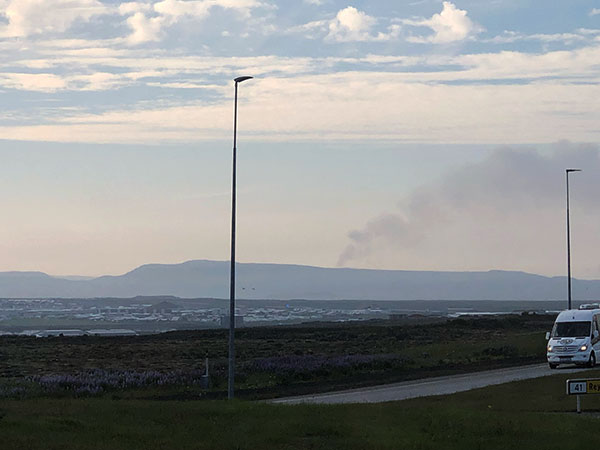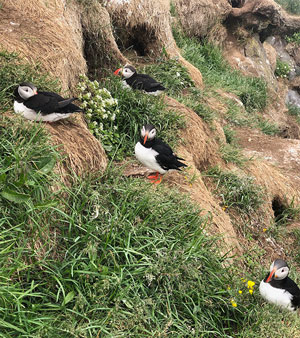Greetings from Palmia Observatory
Well, it seems so short now, but our week long cruise around Iceland has come and gone. We had a marvelous time and we wondered if we might see the active volcano, Gerlingadalur, but couldn't fit it into our schedule, but the volcanic plume was visible on our bus ride from Keflavik Airport to Reykjavik.
 |
| Distant volcanic plume in cell phone photo from airport to Reykjavik (Source: Palmia Observatory) |
If you are interested in the cruise itinerary around the island check out the blog post of April 13. For the story behind how local time in Iceland is differs from it geographical position on the globe check out the blog post of July 2.
Later in the day, we settled into our cruise ship cabin. We did not bring any astronomical cameras because Iceland is located at 64 degrees north latitude and at this time of year the sky does not get very dark. In this next cell phone photo, taken from our cabin veranda, that even at 1:00 am local time, the sky is still quite bright. The camera is facing due north and it is strange to see so much light coming from the north. We get used to seeing the sun rise in the east and set in the west and here we see bright light from the sun which is just completing its journey back from west to east and just about 2 degrees below the horizon. Yep, no need trying to photograph the Northern Lights at this time of year!
 |
| Lights in the north, just not the Northern Lights (Source: Palmia Observatory) |
The cruise, on the Viking Sky, started in Reykjavik and then travelled all the way around the island, with various ports of call along the way and returned to Reykjavik a week later. Ambient temperature was in the 50's and 60's and we had just one bit of rain on one day. We have many opportunities to just scan the horizon and wonder what was just beyond our view. One of the interesting optical phenomena we saw at various times of the day was of a thick dark line along the horizon. Check out this cell phone image which shows a dark linear image at the horizon with an interesting break into a dark section and a lighter colored section. What is going on here?
 |
| Is this cell phone image of the horizon, a Fata Morgana illusion? (Source: Palmia Observatory) |
The Fata Morgana illusion is often seen in high latitudes where the density of different air layers results in a lot of diffraction of light rays, originating at the horizon, but appearing to come to the observer from different angles. So, it seems possible that the dark line at the horizon could be the result of refraction of light as described by Fata Morgana illusion.
 |
| Fata Morgana illusion results from different air layer densities (Source: Wikipedia) |
So, the night skies are too bright to see the Northern Lights and we did find an example of an apparent illusion, but Iceland is full of so much other natural beauty and landscapes. Iceland is a volcanic island with many beautiful fjords carved into the volcanic rock. There is a 825 mile ring road around the whole island that connects the little towns along the coast. Travelling by cruise ship was certainly much easier than making that drive. The ocean was quite calm we could just leisurely watch the beautiful landscape just pass us by. Many of our shore excursions were located in the little towns along the many fjords around the island.
 |
| The many fjords around the island provided splendid views (Source: Palmia Observatory) |
 |
| Melting waters from glaciers results in many rivers and waterfalls (Source: Palmia Observatory) |
Now we are not active birders, but we also didn't want to miss a chance to get up and close and see some Puffins nesting on the seashore. We took a shore excursion which took us to the seaside nesting place where hundreds, maybe thousands of birds had returned to the same nests, burrowed in the ground, that they had used in previous years.
 |
| Puffins on their cliffside nests at the seashore (Source: Palmia Observatory) |
And when we returned to our ship following a land visit ashore, life aboard a cruise ship is a lot of fun too. All passengers had to present their vaccination certificate. Even though we still had to put up with COVID restrictions of wearing a mask while moving about the ship, we could leave them off while seated in the bar or restaurant. We also had frequent temperature checks at entry to ship restaurants and we had to submit a daily saliva sample for PCR testing. The Viking Sky also provided us with a test certificate at the end of the cruise which we would need for our return flight to the US. While ashore, most Icelandic citizens did not wear masks because they have had a high level of vaccination and very low levels of infection.
The ship crew wore masks all the time and still were very accommodating to make sure our cruise experience was very enjoyable. The number of ship passengers was restricted from the nominal level of 900 guests to only about 600 in order to maintain more social distancing guidelines and provide some staterooms for isolation of infected passengers if that should occur.
But enough of some of the realities of travelling in pandemic times, here we see an example of the helpful cruise staff making sure we our glasses were never empty when we wanted more.
 |
| Here, one of many helpful Viking Sky waiters, caters to our every whim (Source: Palmia Observatory) |
When we went ashore we saw plenty of evidence with geothermal activity. Much of Iceland's energy needs are provided by geothermal energy and boiling mud pots and geysers and fumaroles are in evidence everywhere.
 |
| Boiling geothermal mud pots (Source: Palmia Observatory) |
We were able to walk through many areas of strange eroded mounds of volcanic rock.
 |
| Walking through a volcanic wonderland (Source: Palmia Observatory) |
During our cruise around the island, we just briefly went above the Arctic Circle, but Iceland itself is nowhere above the required 66.5 degree latitude. Iceland is located at the spreading zone between the North American tectonic plate and the Eurasian Plate. Hot magma flowed up through this spreading zone to create Iceland about 20 million years ago.
We toured the area located right on top of the spreading zone, but nowhere can you actually stand with one foot on each of the tectonic plates. This area of Iceland was very instrumental in that the early settlers in Iceland would meet at this area and it became the seat where the laws of the land were discussed and adopted starting way back in 800+ AD.
 |
| Walking above the spreading zone between two tectonic plates (Source: Palmia Observatory) |
The volcanic history of modern Iceland has included some devastating eruptions where whole portions of towns were destroyed or evacuated. We visited one of over 400 houses that had been completely covered by volcanic ash during an eruption in 1973 in the Westfjord Islands and just recently the house had been excavated and now is part of a volcano museum built around it. One guide mentioned that this area is Iceland's version of Pompeii in Italy. Going through the museum, where we were surrounded by artifacts and photographs of the eruption and the destruction and evacuation of the townsfolk was a very emotional experience.
 |
| Excavated house at the Eldheimar Volcano Museum (Source: Palmia Observatory) |
So, our week in Iceland is coming to an end, but you have seen a sample of some of the wonderful sites and sounds and people we saw there. Back onboard the ship means that now we have to finally repack our suitcases for the flight back home. One reason cruising is nice is that you only need to unpack once on the ship and then just pack once at the end of the trip.
 |
| Back in cruise ship stateroom trying to get things back in the suitcases (Source: Palmia Observatory) |
Our bus ride back to the airport from the cruise dock in Reykjavik went right by location from where we could see the volcanic plume from the ongoing eruption. The sun position made it hard to photograph it again from the move bus, but at the airport we found a "volcano cam" which was positioned to record any activity from the volcano.
 |
| Volcano cam live display in IcelandAir club lounge (Source: Palmia Observatory) |
When we returned to the observatory, we followed up on some comments about visiting the volcano. It seems that it is possible to take something like a 4-mile round trip hike to view the volcano. Here is a photo from May 24, where Laura Redman took this photo of other hikers looking at the volcano.
 |
| The volcano, Gerlingadalur, is just short hike off of main highway (Source: Laura Redman, May 24) |
Well, we couldn't fit everything, like hiking to the volcano, into our little week long getaway, but we had a wonderful time there in Iceland. When we were unpacking our bags, Resident Astronomer Peggy gave me this surprise hand carved gift, which she had secretly purchased for me from a local artisan in Djupivogur, Iceland. While credit cards are widely used in Iceland, some of the smaller local artisans take only cash, like the Icelandic Krona. Luckily, Peggy had enough local currency to make the purchase. Wow, I do like that carving, made apparently from a piece of driftwood. Iceland has a love of all things involving elves and trolls. Thanks Peggy; it was a total and welcome surprise!
 |
| Hand carved figure from local artisan in Djupivogur, Iceland (Source: Palmia Observatory) |
Until next time,

No comments:
Post a Comment